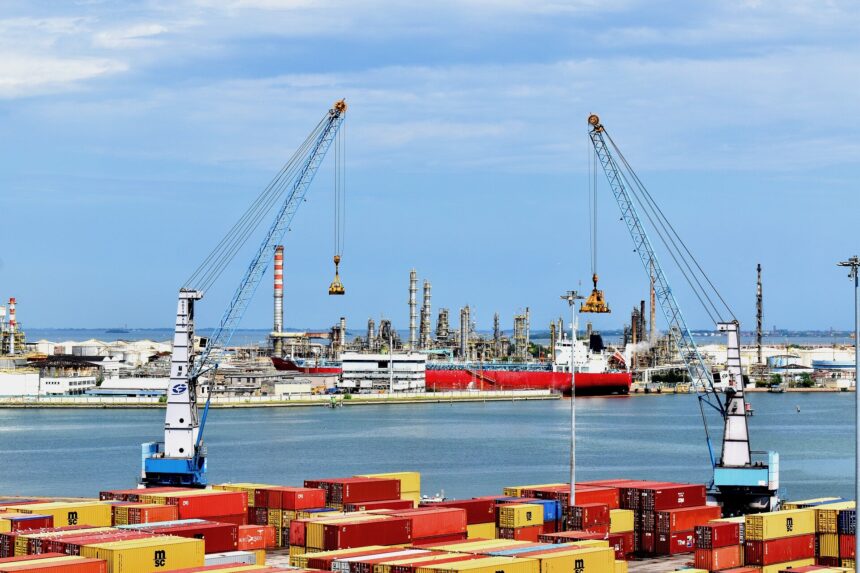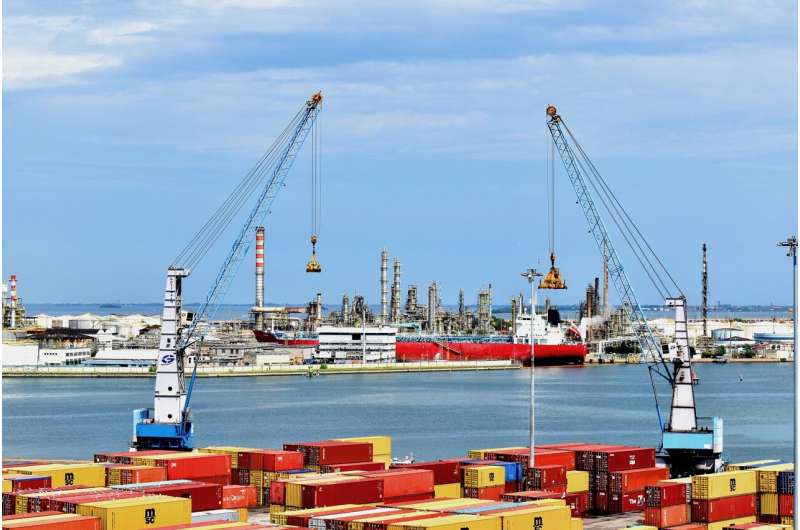Given the spate of news about international trade lately, Americans might be surprised to learn that the U.S. isn’t very dependent on it. Indeed, looking at trade as a percentage of gross domestic product—a metric economists sometimes call the “openness index”—the U.S. is one of the least trade-oriented nations in the world.
In 2022, the U.S. trade-to-GDP ratio was 27%, according to the World Bank. That means the total value of U.S. imports and exports of goods and services combined equaled 27% of the country’s GDP. That’s far below the global average of 63%.
In fact, of the 193 countries examined by the World Bank, only two were less involved in international trade than the U.S. Those were Nigeria, at 26%, and Sudan at 3%. Most world economic powers scored considerably higher, with Germany at 100%, France at 73%, the U.K. at 70%, India at 49%, and China at 38%. Who knew?
Making sense of trade-to-GDP ratios
What do all these numbers mean? It’s tricky because many factors can influence a trade-to-GDP ratio. For example, a country can have a low ratio in large part because it has high tariffs or other protectionist policies; Nigeria, Ethiopia and Pakistan come to mind in this regard. Others, such as Turkmenistan, have low ratios because they’re geographically remote.
A low trade-to-GDP ratio may also arise from the fact that a country is large, wealthy and developed, with a diversified economy that can provide most of the goods and services it needs domestically. We think this explains a lot about the U.S.’s extremely low ratio.
On the other hand, extremely high ratios of well over 300% are found in a few tiny countries due to necessity, location or both. Countries such as Luxembourg and the microstate of San Marino are both located in high-trade Europe and are too small to survive without extensive trade.
Meanwhile, well-positioned locations such as Singapore and Hong Kong have historically thrived as true trade entrepôts. And Djibouti, in East Africa, is increasingly performing a similar function.
It’s also important to look at the trajectory of trade-to-GDP ratios over time. As for the U.S., the ratio rose from 9% in 1960 to just under 11% in 1970 to 25% by 2000.
Since then, the ratio has ranged from 22% in 2002 to 31% in 2012—remaining low compared to almost every other country. The U.S. has registered a relatively low trade-to-GDP ratio throughout its history.
How the US got here: A roller-coaster history of American trade policy
The liberal, open institutional architecture that shapes today’s global economy was largely erected by the U.S. during World War II and shortly afterward. From then until the steep rise of trade-to-GDP ratios from 1970 to 2000, it was easy for U.S. political leaders to support engagement in relatively free trade.
After World War II, a regime of open trade and fixed exchange rates—associated with the Bretton Woods Agreement establishing both the International Monetary Fund and the World Bank in 1944, and the General Agreement on Tariffs and Trade in 1947—succeeded in promoting trade and growth. Those policies also stabilized currencies and balance-of-payments ledgers. Devastated war economies and newly industrializing nations entered and in time helped fashion a new world economic order underwritten and overseen by the U.S.
During the 1950s and 1960s, the U.S. inevitably lost some of its edge in agricultural and manufacturing markets as overseas economies rebounded. But its low trade-to-GDP ratio and ideological commitment to anti-communist allies mitigated domestic political unrest around trade issues. Capital controls and a series of legislative and diplomatic fixes limited international trade’s role in U.S. economic dislocations.
Things changed dramatically in the 1970s, as indicated by the sizable increases in trade-to-GDP ratios for the U.S. and the world as a whole during that period. One key factor was the collapse of state-centered financial regulation. That opened the world to increasingly fluid goods and capital transfers as encouraged under world trade agreements. This was also the period when cheaper goods from Japan and Taiwan began taking hold in the U.S..
Bigger challenges to the stability of postwar working-class livelihoods arose from productivity-enhancing innovations in production, transportation and communications. Two further far-reaching factors were the opening of China’s economy beginning in 1979, and the demise of the Soviet bloc between 1989 and 1991.
Two key free-trade developments took place in the 1990s. The North American Free Trade Agreement of 1993 opened U.S. borders on the north and south to unprecedented transfers of capital, trade and migration. Then, in 2001, China gained “permanent normal trade relations status” with the U.S., thus smoothing its entry into the World Trade Organization. In both cases, the economic dynamism unleashed by the moves was accompanied by major job losses in American manufacturing.
As the U.S. trade-to-GDP ratio climbed steadily from 20% in 1990 to nearly 30% by 2010, trade became an increasingly high-profile issue in U.S. politics. Critics were especially worried by the prospect of trade hurting American jobs and living standards.
After NAFTA’s passage and China’s entry into the WTO, many Americans and interest groups representing them soured on “globalization.” That globalization was embodied in the long-open trade regime put into place after World War II.
So it’s no wonder that Donald Trump was elected president in 2016 while calling for stiff new tariffs on China and a border wall against Mexico. And President Joe Biden hasn’t backed off significantly from Trump’s protectionist trade policies.
U.S. policymakers are unlikely to move further toward trade dependence anytime soon, much less toward any new free-trade agreements. Rather, we’re likely to hear skepticism from both Biden and Trump when the subject of open trade comes up.
Ironically, the open-trade world the U.S. did so much to create seems to depend on Americans limiting their participation in it.
Provided by
The Conversation
This article is republished from The Conversation under a Creative Commons license. Read the original article.![]()
Citation:
The US is one of the world’s least trade-oriented countries—despite laying groundwork for today’s globalized system (2024, April 25)
retrieved 25 April 2024
from https://phys.org/news/2024-04-world-countries-laying-groundwork-today.html
This document is subject to copyright. Apart from any fair dealing for the purpose of private study or research, no
part may be reproduced without the written permission. The content is provided for information purposes only.


